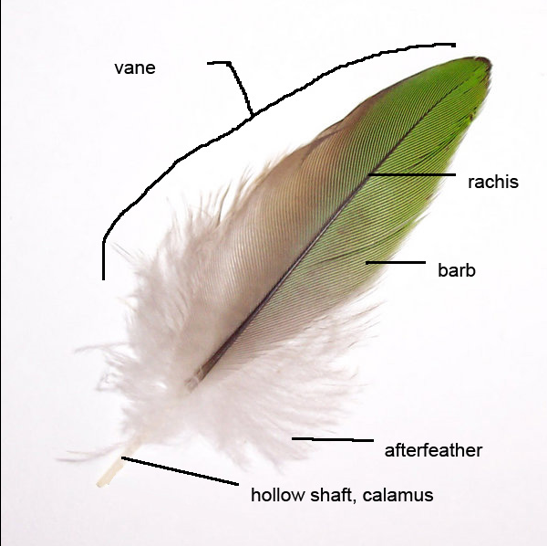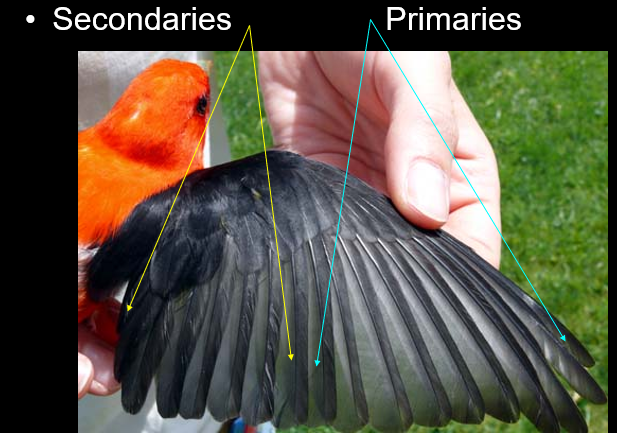Feathers
1/23
There's no tags or description
Looks like no tags are added yet.
Name | Mastery | Learn | Test | Matching | Spaced |
|---|
No study sessions yet.
24 Terms
keel bone
important for flight muscles
scapula looking abdonmen bone
feathers are skin structures
provide insulation, aerodynamic for flight, color for communication and camouflage
modified feathers
swimming, sound production, hear, protection, cleanliness, water repellency, water transport, tactile sensation, support
beta-kertain
fibrous protein polymer
unique to reptiles and birds
makes up feathers
contour feather
long central shaft
calmus and rachis
broad flat vane on either side
calamus
anchors feather in follicle below skin surface
rachis
supports vein
barbs
lateral branches off of rachis
primary elements to the vane
ramus
barbs and barbules form an interlocking but flexible planer surface
ramus
barbuels
tapered central axis with smaller barbules projecting from both sides
barbules consist of a series of single cells linked end to end
can be simple or have projections
barbicels
hooklike
grading contour feathers
hidden, fluffy basal part
insulation
exposed cohesive outer part
variety of functions
difference?
the lack of barbules towards the base

vaned feathers
most conspicuous
smaller contour feathers
flight feathers
smooth overlapping arrangement
reduces turbulence
wing feathers componants
remiges, coverts
remiges
large, stuff, pennaceous
primaries
secondaries
reminges - primaries
outer, distal feathers
forward thrust
vane location is asymmetrical
most birds have 10 primaires
flight efficiency is related to primary structure
next to 0 modifications
remiges - secondaries
inner, proximal
closer to the body of the bird
vane location is symmetrical
10-19, 40 in albatross
major structural modifications are more prevalent

coverts
overlap remiges
reduces drag
covering gaps between feather
tail feathers - rectrices
turning
symmetrical vane location
12 rectrices
6L and 6R
essential feathers
deck feathers
central feathers
major modifications more prevalent
down feathers
soft, fluffy
thermal insulation
lack rachis
trap air next to skin
semiplumes
filoplumes
bristles
powder downs
down feathers - semiplimes
intermediate structures between down and contour feathers
enhance insulation
fill out aerodynamic contours of body plumage
courtship ornaments
down feathers - filoplumes
hairlike
monitor movement and position of adjacent vaned feathers
allows them to hover in the air during hunting
distributed throughout plumage
numerous near mechanically active areas
flight feathers
8-12 filoplumes each
at the base of the feathers
consists of a fine rachis that thickens distally
ends in terminal tuft of barbs w/ barbules
down feathers - bristles
specialized feathers with sensory and protective functions
stiff tapered rachis
few basal barbs
on heads of birds
raptor
simplified so that they’re easier to clean
Also occur as eyelashes in rheas, cuckoos- nostril covering in woodpeckers, jays, crows- around mouth in most aerial insect-eating birds for sensory information
down feathers - powder downs
produce dust-like keratin 1 micrometer in diameter
dispersed throughout feather coat
found in herons, cockatoos
disputed in function
waterproofing?
Parasite prevention?
feather growth
feathers are dead structures
after fully grown
cannot change color or form
can fade or be abrated
mechanisms for damage repair
replace the feather